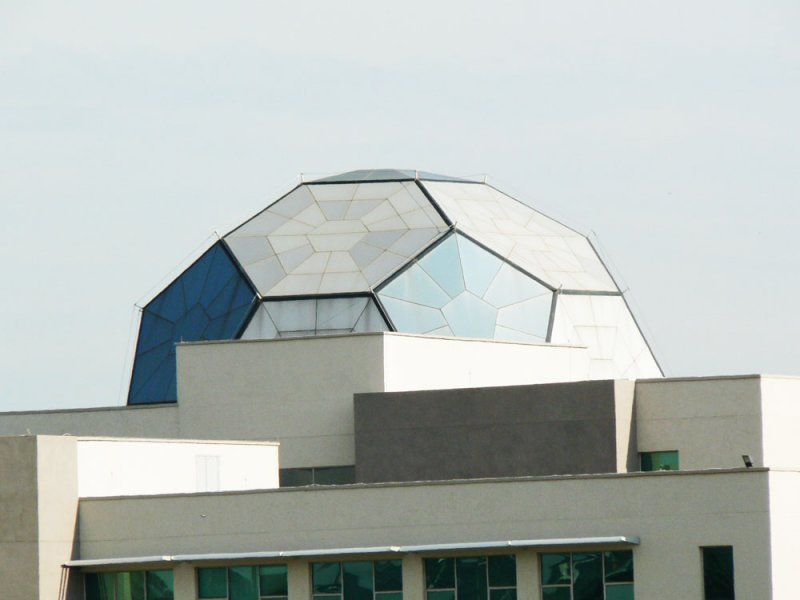
Mzansi Football and Kickoff.com report that the captains and coaches of South Africa’s men’s and women’s national teams failed to cast their vote for FIFA’s Golden Ball as the World’s Player of the Year awards are now known. According to the governing body, the 2010 World Cup hosts were one of just a handful of countries (out of 208) that did not vote. The awards went to Lionel Messi for the second year in a row and Marta for the fifth (?!) year in a row.
“It is the latest botch up by SAFA since the World Cup and makes a mockery of claims the association’s new leadership would bring a new efficiency to the running of the game,” writes kickoff.com. “They failed to enter the country’s teams in the All-Africa Games qualifiers and had to scramble to the Confederation of African Football in Cairo to get a backdoor entry when Namibia withdrew.” Read the full, thoroughly embarrassing details here.
Tag: South Africa
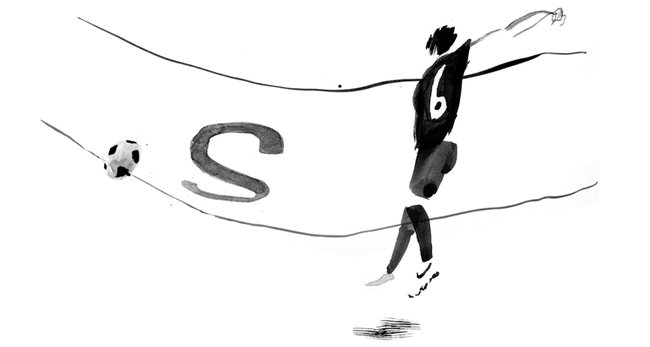
Happy New Year to all!
Back after a month-long break, we are pleased to report that our very own Sean Jacobs made it into the opinion pages of The New York Times yesterday (Sunday, 2 January 2011) as part of the ‘Around the World in 12 Months’ feature. (Some of you may recognize some of the ideas from Sean’s ‘Africa is a Country’ blog). My favorite part is his daughter’s memory of the 2010 World Cup. Click here to read Sean’s entry about the 2010 World Cup in South Africa.
PSL = Premier Soweto League?
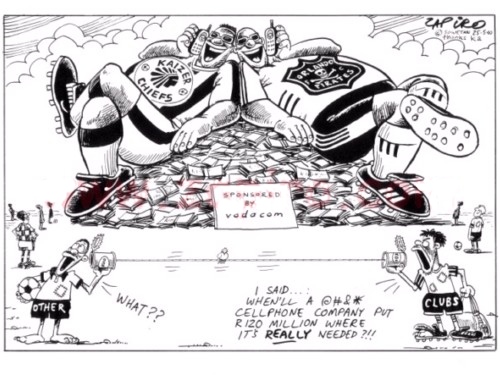
Orlando Pirates and Kaizer Chiefs will meet in the Telkom Knockout Cup final at Soccer City on December 4. That’s the fifth Soweto classic of the 2010-11 season, and it’s not Christmas yet.
With the rest of the PSL attracting small crowds after the 2010 World Cup, it is once again the two most popular and richest clubs in South Africa which are expected to generate excitement, entertainment and, most importantly, revenue.
Supporters of Pirates and Chiefs claim, with some legitimacy, that their sides fully earned the right to play in the League Cup final. Bucs fans point to their side’s pair of impressive 3-0 away wins against SuperSport United and Maritzburg United on the road to the final. The Amakhosi faithful proudly note how Chiefs’ defense has not conceded a goal in the entire competition.
But the recent controversy surrounding the selection of venue for the Maritzburg United – Pirates semifinal strongly suggests that the football-media-business complex that runs the seventh-richest league in the world massaged the outcome so that the final would feature the Soweto derby.
The story goes something like this: Maritzburg United’s shock victory against Sundowns in the quarterfinal set up a home match against Pirates. By chance, the November 21st Telkom Cup semifinal was scheduled five days ahead of a league clash between the same sides at Harry Gwala Stadium in Pietermaritzburg.
Suddenly, the PSL announced that, due to safety and security concerns at Harry Gwala, the Cup semifinal was being moved to Chatsworth stadium in Durban. League officials produced a letter from South African Police Force headquarters that allegedly prevented them from approving the 12,000-seat stadium as a Cup venue. The league’s decision proved deeply unpopular in KwaZulu-Natal’s provincial capital.
In response, Maritzburg United officials flew to Johannesburg to meet with the PSL in a last-ditch attempt to move the game back to the club’s home ground. Club officials produced an official statement by the Pietermaritzburg police that guaranteed spectators’ safety at the grounds and underlined how capacity crowds against Pirates in February and Chiefs in September were handled efficiently and without incident. Moreover, Maritzburg United’s representatives highlighted the PSL’s contradictory position, which deemed Harry Gwala stadium safe for the PSL match on Friday, November 26, but unsafe for the Cup tie.
The sending off of coach Ernst Middendorp in the 43rd minute and of substitute Felix Obasa in the 83rd simply confirmed Maritzburg’s worst fears. “For a small but competitive team like Maritzburg it’s tough enough to play Pirates on a level playing field,” wrote Marc Strydom of The Witness, Pietermaritzburg’s daily newspaper. “But when the odds are stacked against you by the PSL removing home-ground advantage then it’s even tougher.”
As the “home fans” left Chatsworth stadium, they could be excused for wondering whether PSL stood for “Premier Soweto League.”
Agudelo spoils the party: SA 0, USA 1
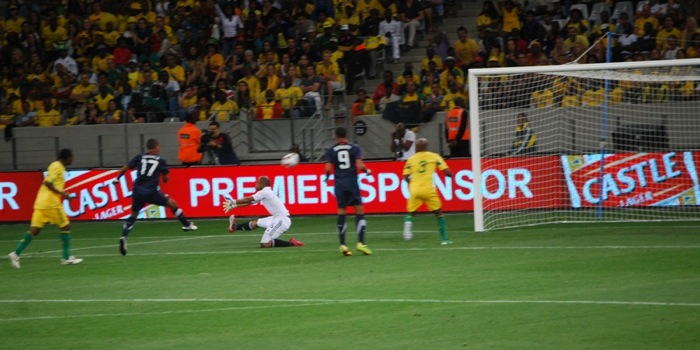
Juan Agudelo — six days shy of his 18th birthday — scored the only goal of the game in the 84th minute and spoiled a massive party in Cape Town. 51,000 of us were on hand at Green Point stadium for this glossy friendly on a warm and breezy late spring evening.
As we walked towards the ground, pubs were full of Bafana fans wearing the yellow national team shirt.
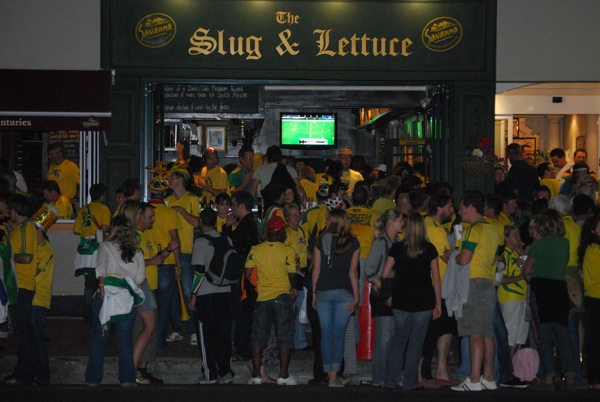
A few Americans chanted their support for the stars-and-stripes and confidently predicted a victory. The World Cup atmosphere was back (minus the FIFA branding).
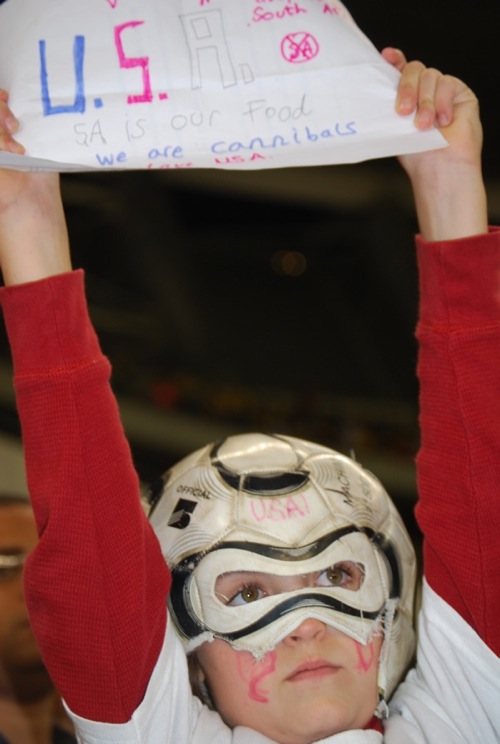
Inside the arena a welcoming vibe enveloped us. The sweet smell of football. The energy of a racially mixed and patriotic crowd. President Zuma meets the teams on the pitch. All for a good cause: the Nelson Mandela Children’s Fund. Fans belt out South Africa’s multilingual national anthem in unison: a rare, precious moment of communitas, football’s unique contribution to a fractured society searching for a shared national identity.
Unfortunately, the football on the night was crap. Let’s call a spade a spade. A strangely lethargic Bafana Bafana side knocked the ball sideways and backwards, while the second-string Americans kept their shape and every once in a while hoofed the ball forward hoping for a break. Still, the two best chances fell to the hosts who, characteristically, squandered them. 0-0 at the half. Perhaps the one silver lining for SA was Leeds striker Davide Somma’s positive debut.
Play resumed at the same monotone pace, passes going astray, nobody really able to turn defenders or take a decent shot at goal, and a series of edgy tackles that did little to improve the flow of the game. A steady stream of substitutions made matters worse. The Mexican wave takes off, a universal symbol of bored fans.
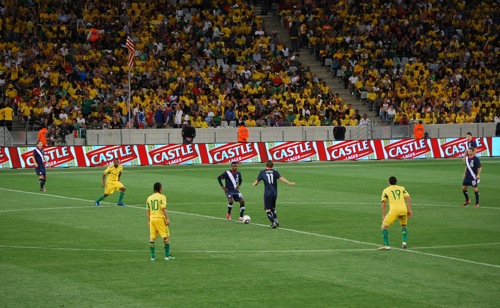
The concocted drama of penalties beckoned until the Colombian-born Agudelo, left wide open in the box, capitalized on an inviting assist by Mikkel Diskerud, a former Norwegian under-19 international whose mother is American. Bafana pressed for the equalizer, but it was too little too late.
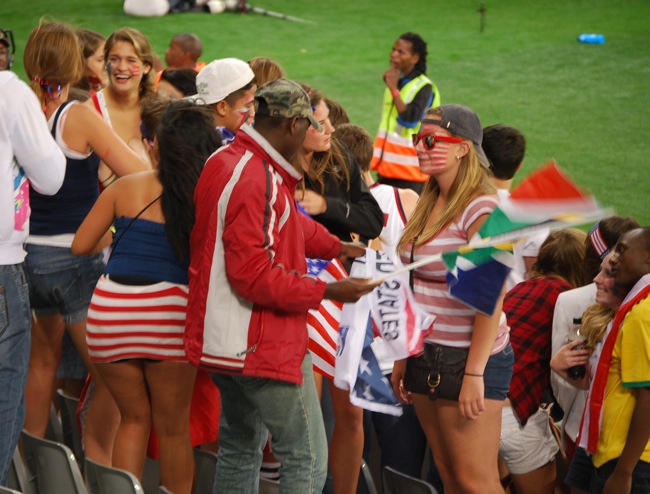
As the home crowd filed out quietly, a group of vociferous American college students wrapped in red-white-and-blue began their celebrations. I couldn’t help but think back to the last time South Africa played in Cape Town: a 3-1 loss to Zambia in September 2007. Is the Mother City cursed?
The Americans Are Coming!
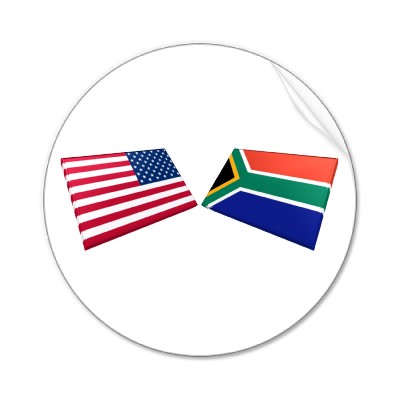 The year of Africa’s first World Cup is coming to an end. Tomorrow I am headed to Cape Town with my family for the South Africa – United States match at Green Point stadium. It’s a friendly branded as the Nelson Mandela Challenge — all proceeds go to the Mandela Children’s Fund.
The year of Africa’s first World Cup is coming to an end. Tomorrow I am headed to Cape Town with my family for the South Africa – United States match at Green Point stadium. It’s a friendly branded as the Nelson Mandela Challenge — all proceeds go to the Mandela Children’s Fund.
A couple of days ago Rodney Reiners of the Cape Argus contacted me and Anders Kelto, an American reporter and former Under-17 US national team captain, for some insights on American soccer to share with South African readers in the build-up to the match. Here’s the interview in full:
Rodney Reiners: What should South Africans know about the establishment and rise of the MLS?
PA: Major League Soccer is a legacy of the 1994 World Cup. It kicked off in 1996 and marked the resurrection of professional soccer in the USA after the demise of the North American Soccer League in 1985. (There were some other attempts at pro soccer in between the NASL and MLS but nothing terribly noteworthy.) I was at the first final at Foxboro Stadium in ’96 with 30,000 mad people in a torrential rain of biblical proportions. It ended 3-2 on a golden goal for DC United: incredible stuff. This league, it seemed to me, was going places. The NASL’s collapse a decade earlier influenced the MLS’s decision to have centralized ownership of player contracts (that is, the league owns contracts not the clubs); to not over-expand the number of teams (we now have 16); make the league more “American” and not overly dependent on over-the-hill foreign stars.
AK: And to prevent the kind of imbalances that doomed the NASL. The New York Cosmos bought the world’s most famous players and drew huge crowds, but just about every other team struggled on the field, and financially.
PA: That’s a very good point Anders. I should add that the commitment of several large corporate sponsors and multi-year TV contracts helped keep MLS afloat in the difficult early years and also legitimized it. Today, MLS competes with ice hockey as the best professional league in the country after The Big Three (NFL, MLB, NBA). That’s a significant achievement and it’s sustainable in the long term.
Heartbreak for South Africa
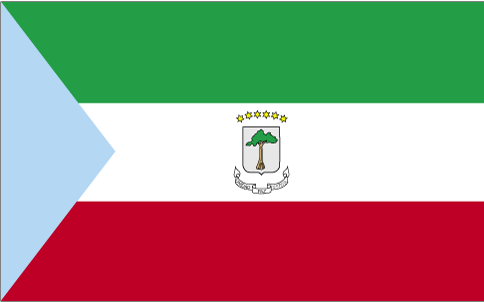
The biggest day in South African women’s football history ended in heartbreak as Equatorial Guinea defeated Banyana Banyana 3-1 after extra time on Thursday at a packed Sinaba stadium in Daveyton outside Johannesburg. After 90 minutes the score was 0-0.
The decisive moment came in the 103rd minute. Salimata Simpore capitalized on a defensive mistake by Van Wyk with a simple finish from just inside the box to give the defending champions a 1-0 lead they did not relinquish.
Psychologically shaken and physically tired, the hosts collapsed. In the 109th minute, a Banyana corner led to a breakaway by Equatorial Guinea that ended with a Jade cross being clumsily deflected by Dludlu inside the far post for an own goal that put the game away. As the deflated home crowd filed out of the stadium, Salimata collected a cross, and in one smooth move faked out a Banyana defender and the goalkeeper to slot home a third goal. Amanda Dlamini saved South Africa’s honor with a delicate chip over the keeper two minutes from time. Final score: 3-1 Equatorial Guinea.
The game had started with the defending champions in control, a fact reflected in their 60 per cent possession of the ball in the first twenty minutes. But the first chance fell to South Africa in the 14th minute when in-form striker Amanda Dlamini squandered the easiest of chances, shooting right at the goalkeeper from close range. Banyana gained confidence and territory in the latter part of the first half, largely thanks to Jafta’s domination of the midfield. Just before the break, Van Wyk’s free kick missile from 40 meters out (!) was tipped over the bar by Miriam. On the ensuing corner, Jafta turned and struck a wonderful shot from near the penalty spot, which forced a miraculous diving save from the Equatorial Guinea keeper. No score after a bruising first half. South Africa would come to rue the missed chances.
The second half was more guarded, neither side wanting to risk making a costly mistake. The Togolese referee seemed far too tolerant of rough tackling, with several players on both sides suffering injuries that required bandaging of heads as well as “holy water” treatment. Despite notching 56 percent of possession, Banyana were unable to penetrate, or seriously threaten the Equatorial Guinea defense anchored by Carolina. Then a turning point in the match: Augustine Makalakalane, South Africa’s coach, replaced Jafta with Makhabane, hoping to gain in creativity and attacking force. Instead the move backfired as Equatorial Guinea asserted control of the midfield. The best chances in the final twenty minutes fell to Chinasa Okoro and Salimata, with goalkeeper Mndaweni doing well to stop them in one-on-one situations.
Dlamini almost won it for South Africa on the stroke of 90 minutes with a high shot to the near post that Miriam parried away for a corner. As we readied ourselves for extra time, Salimata broke away from her marker down the right side but failed to deliver an easy pass to Chinasa for the simplest of tap-in goals. It was a sign of things to come.
Earlier in the day, news reports in South Africa had criticized Equatorial Guinea for quickly giving citizenship to players from Brazil, Cameroon, Ivory Coast, Nigeria, and Senegal. According to kickoff.com, Salimata even played in the AWC qualifiers for Ivory Coast! Cameroon lodged an official protest about Salimata in the group stage, but CAF appears uninterested in pursuing the case.
So Equatorial Guinea and Nigeria — 5-1 winners over Cameroon in the other semifinal — will represent Africa at 2011 Women’s World Cup in Germany. The African champion will be determined on Sunday.
Can Anyone Stop Nigeria?
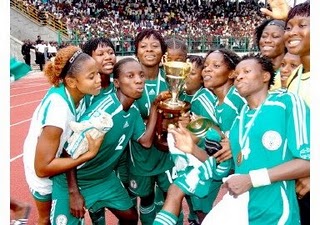
Three victories by a combined score of 10-1 so far in the 2010 African Women’s Championship make Nigeria’s Super Falcons heavy favorites to claim the continental crown.
Led by superstar striker Perpetua Nkwocha’s seven goals, the Super Falcons face Cameroon in tomorrow’s first semifinal. (This match kicks off at 10am. Brunch at Sinaba stadium anyone?). These two West African rivals — in men’s and women’s football — have met in each of the last three AWC tournaments, with Cameroon losing three times (once on penalties) and drawing once. In the 2004 final in South Africa, Cameroon were humiliated by Nigeria 5-0, with Nkwocha scoring four goals. Not a good omen for The Indomitable Lionesses.
South Africa and Equatorial Guinea meet in the second semifinal (3:30pm start, thankfully). This is a rematch of the 2008 title game won by the small oil-rich nation by a score of 2-1. Neither team has played their best football yet so this is likely going to be a riveting contest. Local media have been giving Banyana Banyana unprecedented coverage. The sportive nationalism of the crowds at Sinaba stadium has boosted the confidence, if not the performance, of the South Africans and may well prove decisive against the defending champions.
Prediction: South Africa and Nigeria meet in the final on Sunday.